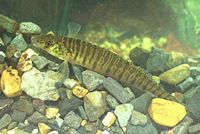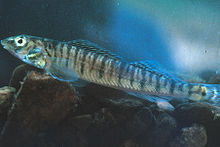- Percina caprodes
-
Percina caprodes 
Percina caprodes Scientific classification Kingdom: Animalia Phylum: Chordata Class: Actinopterygii Order: Perciformes Family: Percidae Genus: Percina Species: P. caprodes Binomial name Percina caprodes
(Rafinesque, 1818)Percina caprodes, the logperch or common logperch, is a fish species of the family Percidae. Like other logperches, it has the typical vertical barring along the flank and a subterminal mouth.
This is the most widespread logperch, commonly found in large parts of the eastern USA and Canada. Like other logperches, they inhabit clear, gravelly streams and lakes, reaching a maximum size of about 18 cm (7 inches) and a maximum age of about 3 years.
Contents
Abstract
The following article is a description of a monitoring plan for the species Percina caprodes. Percina caprodes (commonly referred to as simply the logperch) is a darter species naturally occurring as far north as the St. Lawrence River in Canada, as far west as the Great Lakes, and south throughout the Mississippi River down to the Rio Grande. Percina caprodes is also found as far west as California, where it was introduced in 1953.[1] Logperch are benthic, nonguarding egglayers, whose embryos drift to lentic areas after hatching. Percina caprodes’ population distribution may be under increased predatory pressure from stocked saugeyes.[2] Dams may also exert stress on the fish, by obstructing migratory pathways and inhibiting gene flow.[3] Percina caprodes have also been found to be extremely susceptible to nitrite poisoning.[4] While Percina caprodes is not currently listed as a threatened or endangered species, humans should be aware of our negative impact on the species, and the ways in which we can minimize this impact; most notably, by limiting the construction of dams, by increasing oxygen levels in the tailwaters of existing dams, by limiting the number of predatory gamefish stocked (such as saugeye), by decreasing the amount of silt and debris deposited in streams, and by monitoring nitrite levels in Percina caprodes habitats. Also, a monitoring plan should be created, in which a routine census is taken of the fish in each area of its distribution, and in which invasive species that outcompete P. caprodes, such as Neogobius melanostomus, are removed.[5]
Geographic Distribution of Species
Percina caprodes exhibit a rather large geographic distribution and range. P. caprodes occurs naturally as far north as the St. Lawrence River system in Quebec, and as far south as the Rio Grande River system in southern Texas and northern Mexico. Westwards, logperch are most heavily distributed in the Mississippi River drainage system, and their range extends eastward in freshwater habitats all the way to the Atlantic Ocean. Currently, however, P. caprodes’ range has been artificially extended into California, where it was released into the wild in 1953.[1] P. caprodes’ range, while impressive, has nevertheless been reduced due to the construction of dams,[3] the introduction of stocked predatory species such as walleye and sauger,[2] the introduction of invasive competitors (specifically Neogobius melanostomus),[6] and possibly by erosion around drainage systems.
Ecology
Percina caprodes, like most darter species, dwells in benthic habitats where it forages for food. P. caprodes prefers clear, swift water with rocky or sandy substrate, however, they may be found in any temperate water in their geographic distribution. P. caprodes’ diet consists primarily of benthic invertebrates, which it hunts by flipping over stones with its snout. It appears that logperches are not especially fastidious when foraging, and that they are actually very opportunistic feeders.[7] That being said, chironomids constitute the largest part of a darter’s diet (~54% volumetric contribution), whereas trichopterans and simuliids constituted roughly 15% and 22% volumetric contribution, respectively.[7] However, prey consumption can vary largely by location and season. Some competition surely exists between Percina caprodes and other benthic species with the same native distribution and diet. It is an invasive species, Neogobius melanostomus (round goby), however, that poses the largest competitive threat to P. caprodes. Studies indicate that this is most likely because Neogobius melanostomus better utilizes its space in the environment for shelter, decreasing Percina caprodes’ range, because Neogobius melanostomus is also a more aggressive than the relatively passive P. caprodes, and because N. melanostomus reproduces at a higher rate than P. caprodes.[6] Natural predators of Percina caprodes consist most notably of carnivorous piscivores from the Sander, Micropterus, and Esox genii.[2]
Human induced changes that might reduce Percina caprodes species abundance include the excess stocking of piscivorous fish species, the damming of rivers, introduction of chemicals into watersheds, and erosion caused from human activities. While the top-down effects the addition of excess predators can cause on prey species are relatively well studied, the effects and mechanisms of the other aforementioned human activities may not be so clear.
Life History
Percina caprodes do not reach sexual maturity until approximately 2 years of age. P. caprodes spawn numerous times in the warmer months of the year, typically during spring and summer.[8] P. caprodes lay small demersal adhesive eggs that stick between rocks and substrate . Because of this, logperch tend to spawn in shallow rocky shoals, with high oxygen availability. Upon hatching, the pelagic embryos drift to lentic areas where plankton are more abundant in order to feed. Logperch eggs hatch much earlier than typical darter eggs. Thus, P. caprodes has maintained its ancestral reproductive tendencies, and therefore has not evolved any new adaptations in comparison to other darter species.[9] Some human-induced changes with negative effects on the life history of P. caprodes include the construction of dams and erosion around water drainages.
Current Management
Percina caprodes is currently not a threatened or endangered fish species. Consequently, no apparent steps are being taken to manage the species. While logperches are not currently a threatened species, several human-created changes are negatively influencing P. caprodes. One of these human-induced changes is the construction of dams. Dams are detrimental to logperch for numerous reasons. One reason is that dams typically create less oxygen their tailwaters. This is because the water pushed into the tailwaters comes from oxygen-poor parts of the reservoir. The lack of oxygen this creates can cause undue stress on P. caprodes larvae, because their simple lungs are evolved for high oxygen availability.[9] Another reason dams are detrimental to logperch species is that the constant change of water flow caused by hydroelectric generation creates a large amount of silt deposition on the river floor. Logperch are benthic hunters evolved to hunt and spawn in rocky substrate, and the silt deposited by the hydroelectric generators covers and masks this substrate. Human-initiated erosion also affects logperch in this way. As a result, Percina caprodes obtain food less efficiently, and cannot spawn as efficiently. The overuse of pesticides and fertilizers near watersheds can also have a deleterious effect on P. caprodes by killing or altering aquatic insect life, and by increasing nitrite levels. But perhaps the most deleterious impact on P. caprodes comes from the introduction of the round goby, Neogobius melanostomus,which outcompetes P. caprodes.[6] Through careful farm and land management the introduction of chemicals to watersheds could be greatly reduced. Erosion can largely be avoided by halting deforestation, and the induction of invasive species may be reduced simply by better informing the public of the detrimental effects caused by releasing non-native species into the wild.
Management Recommendations
In order to monitor and manage the species Percina caprodes, population densities and abundance across their range must first be determined. This would be no small undertaking; the geographic range of P. caprodes is quite vast, covering more than half of the continental United States and Canada. Therefore the most efficient course of action may be to determine species abundance by means of geographic cluster sampling. Random samples would be taken from each geographic area, hopefully presenting somewhat reliable data. This type of sampling would save costs and labor, thereby making such a large undertaking feasible. Seines should be favored when practical, such as in small streams and rivers, because they impose less stress on the fish than electroshockers. However, in large rivers such as the Mississippi and in large lakes, electroshockers would be much more practical. Also, when performing sampling, any invasive species found should be noted and removed within federal guidelines. Upon completion of the sampling process, any areas in which Percina caprodes was found to be threatened or endangered should be set aside for protection, if there is high restoration potential. This cataloging of a non-threatened, non-gamefish may seem unnecessary; however, the health of a Percina caprodes population is a great indicator of the health of other fish that a particular area. If a hardy fish species such as P. caprodes is threatened in an area, there is a large chance other species are in danger as well.
External links
- Common Logperch at Animal Diversity Web
References
- ^ a b Cooper,JE.1978. Eggs and Larvae of the Logperch, Percina caprodes. The American Midland Naturalist. 99.2:257-269.
- ^ a b c Denlinger,J, C, S, R, S, Hale, and R A Stein.2006.Seasonal consumptive demand and prey use by stocked saugeyes in Ohio reservois. American Fisheries Society. 135.1:12-27.
- ^ a b Haponski, A E, T A Marth, and C A Stepien.2007. Genetic divergence across a low-head dam:a preliminary analysisusing logperch and greenside darters. Journal of Great Lakes Research. 33.2:117-126.
- ^ Lewis, W M, Morris, D P. 1989. Toxicity of Nitrite to Fish: A Review. Transactions of the American Fisheries Society. 115:183-195.
- ^ Bergstrom, M, A, and Mensinger, A, F. 2009. Interspecific resource competition between the invasive round gobe and three native species: logperch, slimy sculpin, and spoonhead sculpin. Transactions of the American Fisheries Society. 138.5:1009-1017.
- ^ a b c Balshine S, Verma, A, Chant, V, Theysmeyer, T. 2005. Competitive interactions between round gobies and logperch. Journal of Great Lakes Research. 31.1:68-77.
- ^ a b Alford, J B, Beckett, D C. 2007. Selective predation by four darter (Percidae) species on larval chironomids (Diptera) from a Mississippi stream. Environmental Biology of Fishes. 78.4:353-364.
- ^ Platania, S. 1990. Reports and verified occurrence of logperches in Colorado. Southwestern Naturalist. 35:87-88
- ^ a b Paine, M D, Balon, E K. 1984. Early development of the northern logperch, Percina caprodes semifasciata according to the theory of saltatory ontogeny. Environmental Biology of Fishes. 11.3:173-190.
Cooper,JE.1978. Eggs and Larvae of the Logperch, Percina caprodes. The American Midland Naturalist. 99.2:257-269.
Denlinger,J, C, S, R, S, Hale, and R A Stein.2006.Seasonal consumptive demand and prey use by stocked saugeyes in Ohio reservois. American Fisheries Society. 135.1:12-27.
Haponski, A E, T A Marth, and C A Stepien.2007. Genetic divergence across a low-head dam:a preliminary analysisusing logperch and greenside darters. Journal of Great Lakes Research. 33.2:117-126.
Lewis, W M, Morris, D P. 1989. Toxicity of Nitrite to Fish: A Review. Transactions of the American Fisheries Society. 115:183-195.
Bergstrom, M, A, and Mensinger, A, F. 2009. Interspecific resource competition between the invasive round gobe and three native species: logperch, slimy sculpin, and spoonhead sculpin. Transactions of the American Fisheries Society. 138.5:1009-1017.
Balshine S, Verma, A, Chant, V, Theysmeyer, T. 2005. Competitive interactions between round gobies and logperch. Journal of Great Lakes Research. 31.1:68-77.
Alford, J B, Beckett, D C. 2007. Selective predation by four darter (Percidae) species on larval chironomids (Diptera) from a Mississippi stream. Environmental Biology of Fishes. 78.4:353-364.
Platania, S. 1990. Reports and verified occurrence of logperches in Colorado. Southwestern Naturalist. 35:87-88
Paine, M D, Balon, E K. 1984. Early development of the northern logperch, Percina caprodes semifasciata according to the theory of saltatory ontogeny. Environmental Biology of Fishes. 11.3:173-190.

This Percidae article is a stub. You can help Wikipedia by expanding it.

